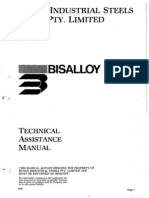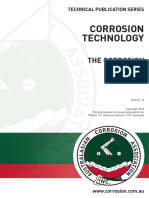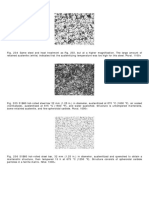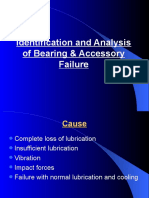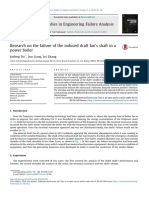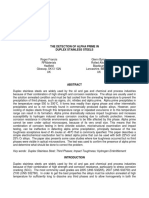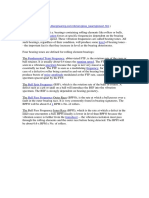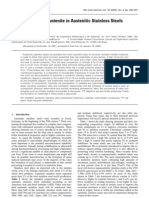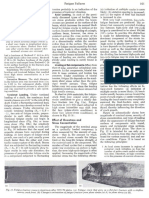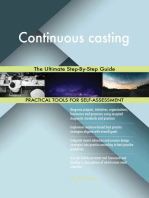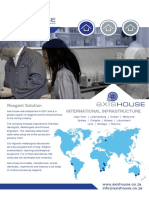300 SS Bolting Failure
300 SS Bolting Failure
Uploaded by
Inspection EngineerCopyright:
Available Formats
300 SS Bolting Failure
300 SS Bolting Failure
Uploaded by
Inspection EngineerOriginal Description:
Original Title
Copyright
Available Formats
Share this document
Did you find this document useful?
Is this content inappropriate?
Copyright:
Available Formats
300 SS Bolting Failure
300 SS Bolting Failure
Uploaded by
Inspection EngineerCopyright:
Available Formats
Would you like to receive a hardcopy of this magazine's full publication?
Please include the month and year of publication and contact Mrs. Erica Riethorst at e.riethorst@kci-world.com
Keywords: Gas leak • Internal bolting • Offshore OIL & GAS
Failed austenitic SS bolts
in valves
In recent years, we have experienced a number of cases with valves
in offshore environments, in which the internal bolting in austenitic
stainless steel failed after some time in the environment. Typically,
it has proven to be valves operating in temperatures of 50–60˚C or
more, and the failure mechanism was chloride-induced stress corrosion
cracking in the austenitic bolts.
Not least for valves in hydrocarbon service, such bolt failures may result
in a major loss of containment with extensive gas leaks possessing a
high risk potential of ignition resulting in fire or explosion.
Figure 2: Norwegian case from 2012.
By Kristian Lund Jepsen and Per Grumsen, Ramboll Oil & Gas, Esbjerg, Denmark
During disassembling the valve onshore,
The phenomenon has been seen in both in September 2012. A two-piece ball it was observed that the upper five stud
the Middle East (Persian Gulf) and in the valve with austenitic stainless steel bolts bolts had fractured already before the
Danish and Norwegian North Sea. failed as the bolts broke. The failed valve pressure test, and that one bolt had partly
In one case, offshore Qatar (reported in was operating at service temperatures cracked too. This bolt fractured totally
2008), a two-piece 2” ball valve on a fuel exceeding 60˚C and had bolts in 316 SS. during the pressure test, which caused
gas skid, in which all four internal bolts In the Norwegian case, further 17 opening of the valve housing – and with
keeping the two parts together failed. similar valves in equivalent services were that the leak – see Figure 4.
The failure resulted in the release of identified in the same plant before any A metallurgical examination of a cross-
almost 500 kg (= 500 m3 at atmospheric incident took place. section through one of the fractured
pressure) of natural gas during a 3 minute The case from the Danish North Sea AISI 316 stud bolts suggested that the
release. Fortunately no ignition of the gas turned up as an 8” super duplex stainless root cause of the fractures was chloride-
took place. The bolts were in 304 SS. steel process valve failure (valve for induced stress corrosion cracking – see
In that case, the owner identified a produced water, temperature approx. Figure 5.
high number of equivalent valves in 70°C), which – fortunately - occurred Based on this result of the examination, a
equivalent service conditions. The valves during a standard leak test. warning was sent out, and an inspection
were prioritised in 3 groups (1, 2 and 3) The valve was equipped with AISI 316 of the pipe system for the presence of
depending on the risk potential. All valves austenitic stainless steel bolts (A4-bolts). possible other valves of the same type
in group 1 (the ones with the highest risk The valve started to leak due to opening was initiated.
rating) were replaced within months after of the top part between body and flange Several other valves of the same type,
the incident. The new valves were with before full test pressure was reached – which had suffered the same type of
bolts in super duplex stainless steel. see Figure 4. bolt cracking/fracture, were detected
A rather similar event was reported from The valve was then sent onshore for during this inspection, and immediate
a platform in the Norwegian North Sea repair. replacement of these valves was carried
opened assembly
Loose AISI 316
stud bolts
Figure 1: Norwegian case from 2012. Bolts were
in 316 SS. Figure 3: The valve in opened condition – immediately after pressure testing.
www.valve-world.net March 2014 1
OIL & GAS
Five bolts already fractured
One partly cracked bolt fractured during the test
Figure 4: Failed valve with six fractured stud bolts in the upper part – after disassembly.
out in order to reduce the risk of A high tensile stress level in a material if the other parameters necessary are
catastrophic leaks occurring during normal is e.g. present as the result of the present too.
service. manufacturing process (rolling, cold- In the actual cases from Norway and
New valves and repaired valves are forming, welding, tightening of bolts etc.), Denmark, the temperature of the medium
equipped with super duplex stainless steel which results in a high static stress level in inside the valves during normal service
bolts. the stainless steel material. is reported to be sufficiently above the
In the actual cases, primarily the tightening “lower level”, at which this cracking
Chloride-induced stress of the bolts has resulted in a high tensile mechanism may occur.
corrosion cracking (SCC) stress level in the bolt material. The conditions, under which SCC (stress
Chloride-induced stress corrosion cracking A high temperature (in practice approx. corrosion cracking) may take place due to
is a type of environmental cracking caused 50-60°C may be sufficient for standard chlorides, are shown in Figure 6 below.
by the simultaneous action of a corrosive austenitic stainless steel) most often Chlorides may be present in various
agent (aqueous chlorides) and sustained originates from a medium present inside types of mediums transported in process
tensile stress in the material. pipes and vessels etc. – however, plants – however, common to the valve
This actual type of cracking primarily especially at locations, where a warm failures described above is that chlorides
occurs in austenitic stainless steels, if the climate is present (sub-tropical or necessary for the actual failure type have
following criteria are fulfilled: tropical), the temperature of external been added from the surroundings – thus
• High tensile stress level surfaces may reach heights, in which resulting in the chlorides coming into
• High temperature austenitic stainless steel suffers from contact with external surfaces of valves
• High chloride concentration chloride-induced stress corrosion cracking, and piping.
Fractured stud bolt Fracture surface
Figure5: Fractured stud bolt and micro-photo of cross-section through fractured surface. Note the comprehensive cracking of the bolt material up to the fracture
surface. The crack image to the right (trans-granular cracks) suggests the cracking mechanism to be chloride-induced stress corrosion cracking. Red-colouring of
the bolt threads due to corrosion is seen.
2 March 2014 www.valve-world.net
OIL & GAS
Figure 6: Conditions under which SCC may be experienced. It is seen
for the austenitic stainless steels (304/304L and 316/316L), that the
conditions may be present from about 50˚C service temperatures, if high
chloride concentrations are present (courtesy of Sandvik). Figure 7: Transgranular stress corrosion cracking.
Especially in marine environments, this may been reported. The cracking has been temperatures above 50˚C on their
be a problem, which must be taken into caused by evaporation of water containing installations and replace such valves or at
consideration, when selecting materials. only small – and often insignificant - least the bolts. For stainless steel valves,
Also at indoor installations, chlorides amounts of chlorides on heated surfaces. super duplex stainless steel bolts are often
may be added to stainless steel external Thus evaporation of such water added a good alternative.
surfaces – e.g. during deluge tests carried continuously to warm surfaces may over It is also recommended to change
out using seawater or from dripping water time lead to the accumulation of chlorides - piping and valve specifications to avoid
from leaking pipe systems etc. finally resulting in a chloride level, which purchasing valves with austenitic stainless
Adding water to heated surfaces will result makes stress corrosion cracking possible – steel bolts in the future.
in evaporation of the water - to a certain even despite a “harmless environment”. It may even be required to introduce
extent – resulting in increased risk of high checks of received new valves into stock
chloride concentration on the surfaces in Recommendations to ensure that the specified bolting
question. It is strongly recommended that operators material has been implemented. Some
During the years, several failures in of offshore oil/gas installations investigate, of the cases above are cases, in which
stainless steel items caused by chloride- if they have valves with austenitic stainless austenitic bolting had not been specified
induced stress corrosion cracking have steel bolts in service conditions with in the purchase specifications.
About the author
Kristian Lund Jepsen is Senior Chief Consultant at Ramboll Oil & Gas in Esbjerg, Denmark. Mr. Jepsen holds
an M.Sc. in mechanical engineering from the Technical University of Denmark, Copenhagen, from 1981. He
has been with Ramboll Oil & Gas for about 18 years. Mr. Jepsen is a technical expert within the oil and gas
production and processing areas, with special focus on mechanical equipment and systems including valves.
Earlier in his career, he has held positions in large energy companies such as Maersk Oil and Halliburton.
Per Grumsen is Senior Chief Consultant at Ramboll Oil & Gas in Esbjerg, Denmark. Mr. Grumsen was
educated as marine engineer in Esbjerg, Denmark in 1980. He has been with Ramboll Oil & Gas as material
expert since 2012 and had formerly a long career (approx. 30 years) at the material department of FORCE
Technology in Esbjerg. Fields of activities have among other things been: Failure investigation and analysis
(corrosion problems, cracks and fractures, breakdown of engines, turbines, valves etc.), metallurgical
examinations, material selection, NDE-methods, corrosion prevention e.g. including specification and
inspection of surface treatments (coatings, paint systems, hot-dip galvanizing etc.).
www.valve-world.net March 2014 3
You might also like
- Innovative In-Situ Repair of A High Temperature Steam Super Heater CoilDocument13 pagesInnovative In-Situ Repair of A High Temperature Steam Super Heater Coilvaratharajan g r100% (1)
- Determination of The Butane Activity of Activated Carbon: Standard Test Method ForDocument4 pagesDetermination of The Butane Activity of Activated Carbon: Standard Test Method ForMayur JadhavNo ratings yet
- Reduce Bicine Corrosion PDFDocument7 pagesReduce Bicine Corrosion PDFmahesh070No ratings yet
- MW 35 and MW 36 Wind Sensors - LR PDFDocument4 pagesMW 35 and MW 36 Wind Sensors - LR PDFchristianson_87No ratings yet
- Technical Brief: Avoiding Bolt Failures: F E A T U R EDocument2 pagesTechnical Brief: Avoiding Bolt Failures: F E A T U R EkanosriNo ratings yet
- Fatigue Welding JointDocument12 pagesFatigue Welding Jointilyong han100% (1)
- Failure Analysis of SA-213TP347H High-TemperatureDocument6 pagesFailure Analysis of SA-213TP347H High-TemperatureLakshminarayanNo ratings yet
- 4-Failure Mode AnalysisDocument40 pages4-Failure Mode AnalysisAheza DesireNo ratings yet
- Bisalloy: Bunge Industrial Steels Pty. LimitedDocument65 pagesBisalloy: Bunge Industrial Steels Pty. Limitedramaus100% (1)
- Feb 2004 PE ArticleDocument2 pagesFeb 2004 PE ArticleWaleed GamalNo ratings yet
- ECCC - RECOMMENDATIONS-2014-Vol6 - 2Document7 pagesECCC - RECOMMENDATIONS-2014-Vol6 - 2IndraNo ratings yet
- Evaluation of Microstructure of High Pressure TurbineDocument8 pagesEvaluation of Microstructure of High Pressure TurbineAndrea CalderaNo ratings yet
- Failure Analysis of Helical Gear Shaft in Hot Rolling MillDocument7 pagesFailure Analysis of Helical Gear Shaft in Hot Rolling Millvasundhara singhNo ratings yet
- Ferrous Alloys Stainless SteelsDocument41 pagesFerrous Alloys Stainless SteelsSumedh SinghNo ratings yet
- Analysis of Steam Turbine Blade Failure LOW PRESSURE TURBINEDocument7 pagesAnalysis of Steam Turbine Blade Failure LOW PRESSURE TURBINEpoojaNo ratings yet
- 2 How To Make A Pump Selection - Intro To PumpsDocument7 pages2 How To Make A Pump Selection - Intro To PumpsMohammed MustafaNo ratings yet
- Extending Fluid System ComponentDocument5 pagesExtending Fluid System Componenterwin dwi laksonoNo ratings yet
- Nickel Base Alloys: Topics To Discuss .Document15 pagesNickel Base Alloys: Topics To Discuss .Muhammad Zam-zamNo ratings yet
- As 5016-2004 Metallic Materials - Conversion of Hardness ValuesDocument10 pagesAs 5016-2004 Metallic Materials - Conversion of Hardness ValuesSAI Global - APAC0% (1)
- ACA 3 Corrosion Technology The Corrosion ProcessDocument28 pagesACA 3 Corrosion Technology The Corrosion ProcessnickchoNo ratings yet
- Spiral Wound Gasket FailureDocument24 pagesSpiral Wound Gasket FailureHatem JafouraNo ratings yet
- An Integrated Study of A Gearbox Failure.Document12 pagesAn Integrated Study of A Gearbox Failure.dalia elgazzarNo ratings yet
- Guidelines For Hard Facing Onto SteelsDocument7 pagesGuidelines For Hard Facing Onto SteelsmohamedfirozNo ratings yet
- SEM FractographyDocument17 pagesSEM FractographyAnshuman Roy0% (1)
- Metal Structure and Metallography TechniqueDocument11 pagesMetal Structure and Metallography TechniqueLilian RoseNo ratings yet
- Identification and Analysis of Bearing & Accessory FailureDocument13 pagesIdentification and Analysis of Bearing & Accessory FailureAbul Ishaque Mohammed IbrahimNo ratings yet
- Small Work Bid No. 15-Sw39 Rocky Reach Unit C-8 Bearing RebabbittngDocument13 pagesSmall Work Bid No. 15-Sw39 Rocky Reach Unit C-8 Bearing Rebabbittngarindam misra8No ratings yet
- PVP2017-65826 BasselDocument9 pagesPVP2017-65826 Basselmuhammed.eNo ratings yet
- Failure Analyses of Six Cylinder Aircraft Engine CrankshaftsDocument18 pagesFailure Analyses of Six Cylinder Aircraft Engine CrankshaftsJonathan Hernandez100% (1)
- Fastener FatigueDocument14 pagesFastener FatigueiodabaotNo ratings yet
- Research On The Failure of The Induced Draft Fan's Shaft in A Power BoilerDocument8 pagesResearch On The Failure of The Induced Draft Fan's Shaft in A Power BoilernaderbahramiNo ratings yet
- The Detection of Alpha Prime in Duplex Stainless SteelsDocument10 pagesThe Detection of Alpha Prime in Duplex Stainless Steelsapply19842371No ratings yet
- Bearing Vibration FrequenciesDocument2 pagesBearing Vibration Frequenciesjedi_641274026No ratings yet
- Recurring Failures of Rod Mill Liner Bolts by W.Pascheto (XPS)Document16 pagesRecurring Failures of Rod Mill Liner Bolts by W.Pascheto (XPS)Swapnil SoniNo ratings yet
- Heat Exchnager, AUCDocument82 pagesHeat Exchnager, AUCSaid Alauddeen Faisz100% (1)
- Stainless Steel Grades 2008 01Document2 pagesStainless Steel Grades 2008 01Rahul LavandNo ratings yet
- Decomposition of Austenite in Austenitic Stainless SteelsDocument13 pagesDecomposition of Austenite in Austenitic Stainless SteelsregistrosegNo ratings yet
- MEE Avoiding Bolt FailuresDocument2 pagesMEE Avoiding Bolt Failuresridwan347No ratings yet
- Experience With Maintaining A 40 Year Old Reformer: Ajay Joshi & Stan HeaneyDocument14 pagesExperience With Maintaining A 40 Year Old Reformer: Ajay Joshi & Stan Heaneyvaratharajan g rNo ratings yet
- LT32599 10Document38 pagesLT32599 10Angela Bailey100% (1)
- Failure of An Intermediate Gearbox of A HelicopterDocument16 pagesFailure of An Intermediate Gearbox of A HelicopterAPINo ratings yet
- HRST Boiler Biz - Volume 15 Issue 1 - 2014Document8 pagesHRST Boiler Biz - Volume 15 Issue 1 - 2014IlkuNo ratings yet
- Effects of CR Content and Environmental Factors On Flow Accelerated Corrosion Rate of Carbon SteelsDocument4 pagesEffects of CR Content and Environmental Factors On Flow Accelerated Corrosion Rate of Carbon SteelsAPINo ratings yet
- The Effects of Joint Design, Bolting Procedure and Load Eccentricity On Fatigue Failure Characteristics of High-Strength Steel BoltsDocument22 pagesThe Effects of Joint Design, Bolting Procedure and Load Eccentricity On Fatigue Failure Characteristics of High-Strength Steel BoltsLucas InacioNo ratings yet
- Stress Corrosion CrackingDocument10 pagesStress Corrosion Crackingmohamed.eldesouky9120100% (1)
- Fatigue in High Strength BoltDocument10 pagesFatigue in High Strength BoltEgyptian ResearcherNo ratings yet
- In Axial Loading: Types StressDocument6 pagesIn Axial Loading: Types StressPaúlNinaquispeNo ratings yet
- AFT XStream Data SheetDocument2 pagesAFT XStream Data SheetdelitesoftNo ratings yet
- Steam Fireside MaterialsDocument87 pagesSteam Fireside MaterialsdrbeyerNo ratings yet
- Failure Analysis of AISI 410 Stainless-Steel Piston Rod in Spillway Floodgate (2019)Document12 pagesFailure Analysis of AISI 410 Stainless-Steel Piston Rod in Spillway Floodgate (2019)Dzaky ArizsaNo ratings yet
- PREn - Pitting Resistance Equivalent NumberDocument2 pagesPREn - Pitting Resistance Equivalent NumberJacinto Gomez Emboletti50% (2)
- Ti Condenser TubingDocument8 pagesTi Condenser Tubingaman131No ratings yet
- Steam Turbine Rotor Discs Repair - RevDocument39 pagesSteam Turbine Rotor Discs Repair - Revalfattah25No ratings yet
- Failure AnalysisDocument7 pagesFailure AnalysisbefoaNo ratings yet
- Case Study of Bolt FailureDocument13 pagesCase Study of Bolt FailureJB MadeleineNo ratings yet
- Oxidation Behavior of AISI 321, AISI 316, and AISI 409 Stainless Steels: Kinetic, Thermodynamic, and Diffusion StudiesDocument9 pagesOxidation Behavior of AISI 321, AISI 316, and AISI 409 Stainless Steels: Kinetic, Thermodynamic, and Diffusion StudiesJuliana FortunatoNo ratings yet
- 1.corrosion TheoryDocument77 pages1.corrosion Theoryamitvaze316100% (1)
- Bossard White Paper Material Fatigue enDocument16 pagesBossard White Paper Material Fatigue enHeviiNo ratings yet
- Fatigue Failure of An Idle Gear Shaft of A GearboxDocument9 pagesFatigue Failure of An Idle Gear Shaft of A GearboxGuilherme BandeiraNo ratings yet
- Wear: Materials, Mechanisms and PracticeFrom EverandWear: Materials, Mechanisms and PracticeGwidon W. StachowiakNo ratings yet
- Energy Harvesting Using Mechanical Vibrations A Complete GuideFrom EverandEnergy Harvesting Using Mechanical Vibrations A Complete GuideNo ratings yet
- NR-SR Materials and Corrosion EngineerDocument3 pagesNR-SR Materials and Corrosion EngineerInspection EngineerNo ratings yet
- Metal Dusting PDFDocument13 pagesMetal Dusting PDFInspection EngineerNo ratings yet
- Pressure Equipment IMDocument43 pagesPressure Equipment IMInspection EngineerNo ratings yet
- Guide-Control-Valve BookDocument120 pagesGuide-Control-Valve BookInspection Engineer100% (1)
- Relief Valves: Gases and Gas EquipmentDocument22 pagesRelief Valves: Gases and Gas EquipmentInspection EngineerNo ratings yet
- Pressure Relief DevicesDocument5 pagesPressure Relief DevicesInspection Engineer100% (1)
- Pressure Relief DevicesDocument5 pagesPressure Relief DevicesInspection Engineer100% (1)
- Simplify Materials Selection: Your Guide To Making Choices That Reduce The Impact of CorrosionDocument37 pagesSimplify Materials Selection: Your Guide To Making Choices That Reduce The Impact of CorrosionInspection EngineerNo ratings yet
- Fatigue Fracture MechanicsDocument12 pagesFatigue Fracture MechanicsInspection Engineer0% (1)
- Tapcoenpro: The Value of A Trusted PartnerDocument4 pagesTapcoenpro: The Value of A Trusted PartnerInspection EngineerNo ratings yet
- Mek4450 Ife Day1 Kha PDFDocument31 pagesMek4450 Ife Day1 Kha PDFInspection EngineerNo ratings yet
- Materials For Engineering 20ME11T Unit V - HEAT TREATMENT PROCESSESDocument16 pagesMaterials For Engineering 20ME11T Unit V - HEAT TREATMENT PROCESSESThanmay JS100% (2)
- M3 - Alfa LavalDocument2 pagesM3 - Alfa Lavaljuan atahuaNo ratings yet
- Thermodynamic Constraints of Slag FormationDocument4 pagesThermodynamic Constraints of Slag FormationPinNo ratings yet
- Broth and AgarDocument1 pageBroth and AgarVargheseNo ratings yet
- 099100-1 - Intumescent Fireproof CoatingDocument4 pages099100-1 - Intumescent Fireproof Coatinglink4biz1974No ratings yet
- Chemistry Vocabulary SheetDocument2 pagesChemistry Vocabulary Sheetapi-326958203No ratings yet
- Curing of ConcreteDocument11 pagesCuring of ConcreteNeeraj VashistNo ratings yet
- R05323 P 001a X009 0042 PDFDocument464 pagesR05323 P 001a X009 0042 PDFcquibajoNo ratings yet
- FDocument23 pagesFFadhly Hidaya PutraNo ratings yet
- En 10208-1Document49 pagesEn 10208-1Semcabih100% (4)
- WPS Format For AWS D1.1 - PQR - SMAWDocument3 pagesWPS Format For AWS D1.1 - PQR - SMAWThe Welding Inspections Community100% (3)
- Shimadzu Journal For WebDocument38 pagesShimadzu Journal For WebRandy Gibson Oloan SigalinggingNo ratings yet
- Heat of MixingDocument7 pagesHeat of Mixingandreyan P.NNo ratings yet
- Scotchrap™ 52 Tape: Installation TechniquesDocument7 pagesScotchrap™ 52 Tape: Installation TechniquesHJNo ratings yet
- CH 12 EquilibriumDocument30 pagesCH 12 Equilibriumuser308100No ratings yet
- Flow in Open ChannelDocument24 pagesFlow in Open ChannelSue IlaNo ratings yet
- EPA Methods Water Analysis B EPA EN PDFDocument8 pagesEPA Methods Water Analysis B EPA EN PDFDOUGLAS SÁNCHEZNo ratings yet
- Performance Analysis of Photonic Crystal Fiber Biosensor Using Surface Plasmon ResonanceDocument6 pagesPerformance Analysis of Photonic Crystal Fiber Biosensor Using Surface Plasmon ResonanceFouthikaNo ratings yet
- 1000ppm Atomic Absorption StandardsDocument5 pages1000ppm Atomic Absorption StandardsSusyana SamiranNo ratings yet
- 5-Fastener Design Criteria PDFDocument1 page5-Fastener Design Criteria PDFmurdicksNo ratings yet
- Wood Pyrolysis Using Aspen Plus Simulation and Its Industrial ApplicationDocument20 pagesWood Pyrolysis Using Aspen Plus Simulation and Its Industrial ApplicationAloy PalitNo ratings yet
- Good Full Lab Report Sample 1Document3 pagesGood Full Lab Report Sample 1nayelimoreno14300No ratings yet
- Reagent Solution International Infrastructure: WWW - Axishouse.co - Za Info@axishouse - Co.zaDocument2 pagesReagent Solution International Infrastructure: WWW - Axishouse.co - Za Info@axishouse - Co.zaMatias EnriqueNo ratings yet
- Optimisation of Bread Quality Produced From Wheat and Proso Millet (Panicum PDFDocument6 pagesOptimisation of Bread Quality Produced From Wheat and Proso Millet (Panicum PDFZobyNo ratings yet
- Validation Soft Soil Creep Model Undrained Triaxial Creep Behaviour Haney Clay 2016Document6 pagesValidation Soft Soil Creep Model Undrained Triaxial Creep Behaviour Haney Clay 2016boris1516No ratings yet
- BgalDocument13 pagesBgalFiqa SuccessNo ratings yet
- Coordination CompoundDocument19 pagesCoordination CompoundJatindra PatelNo ratings yet
- 1384699352Document26 pages1384699352Ankur BattaNo ratings yet








